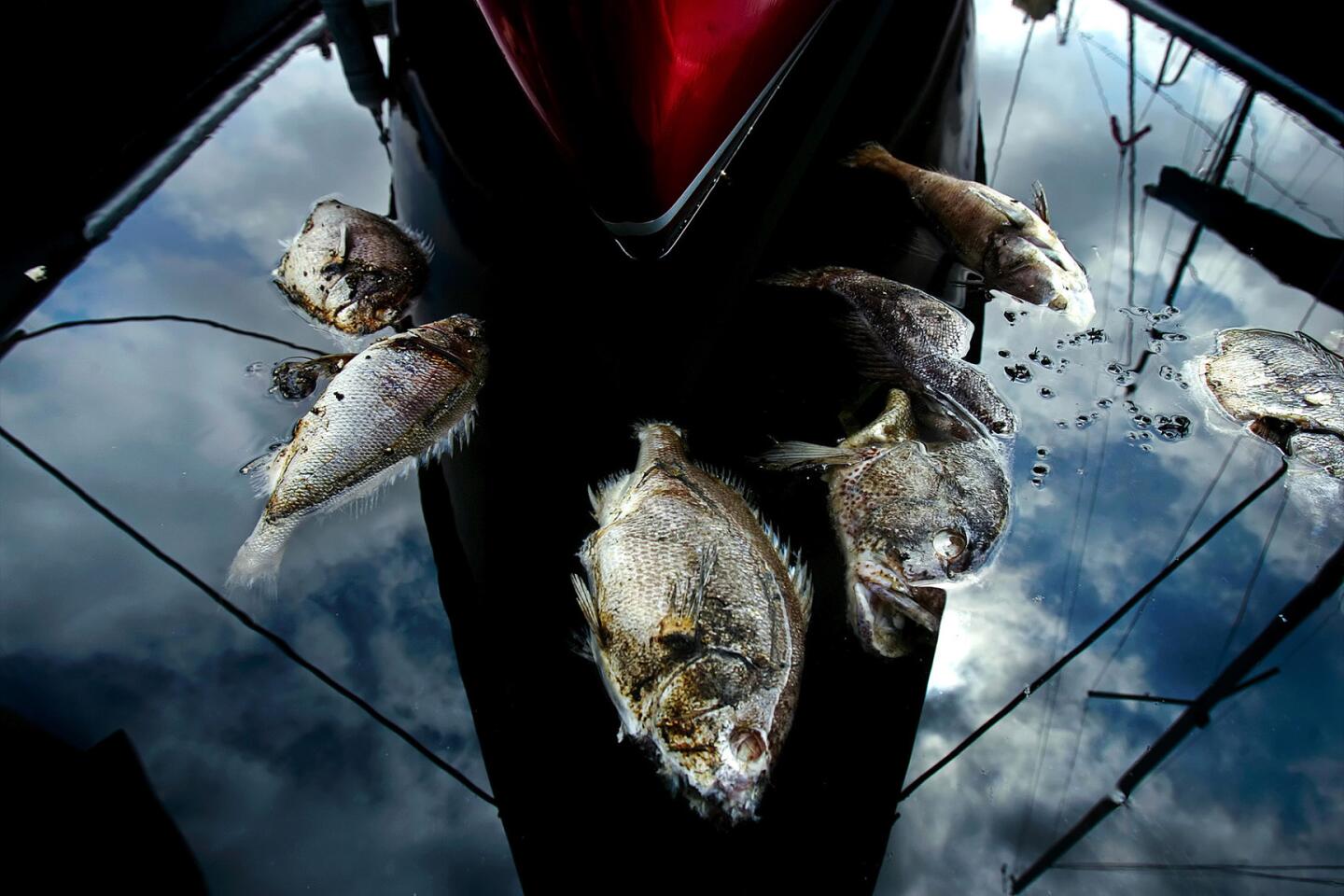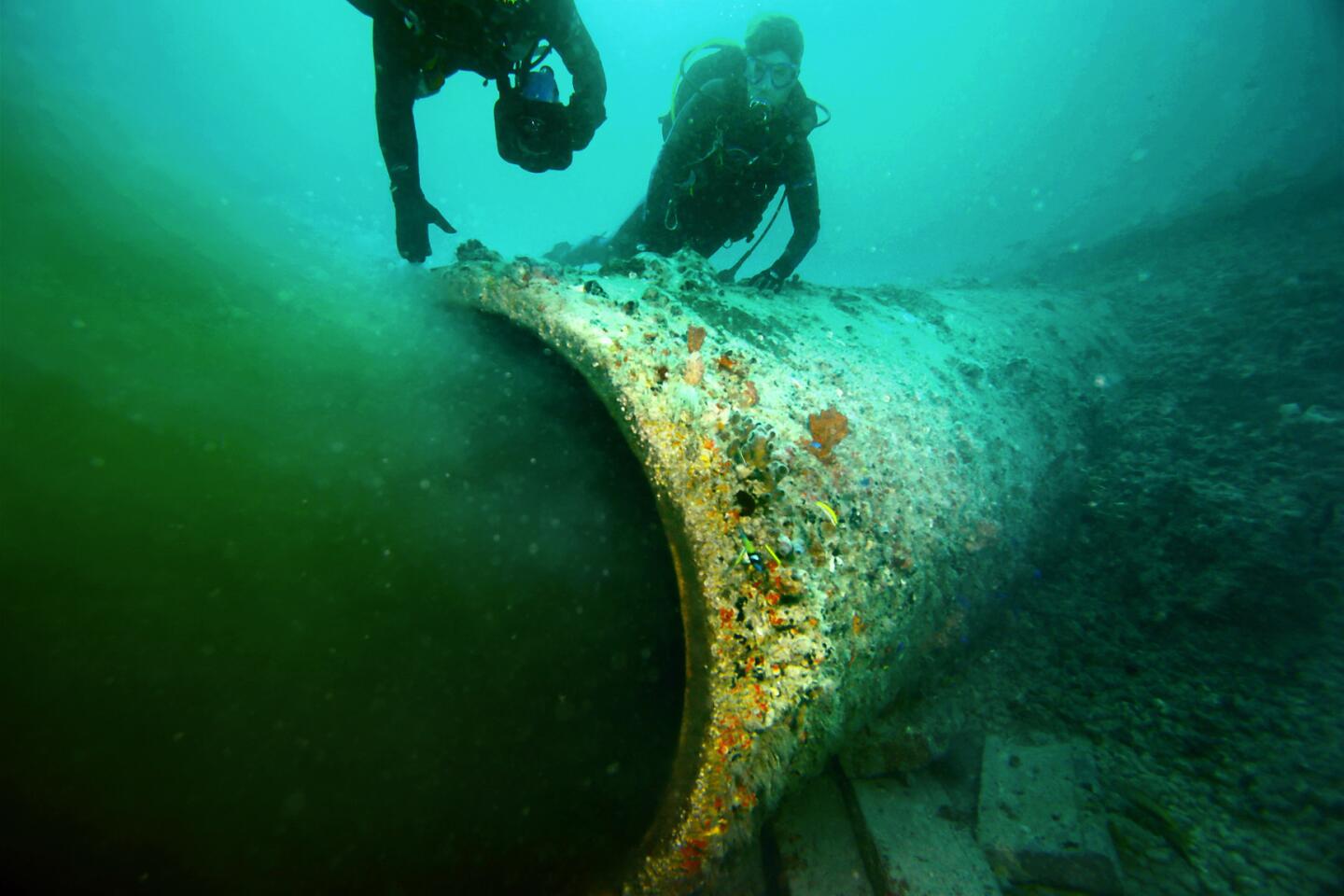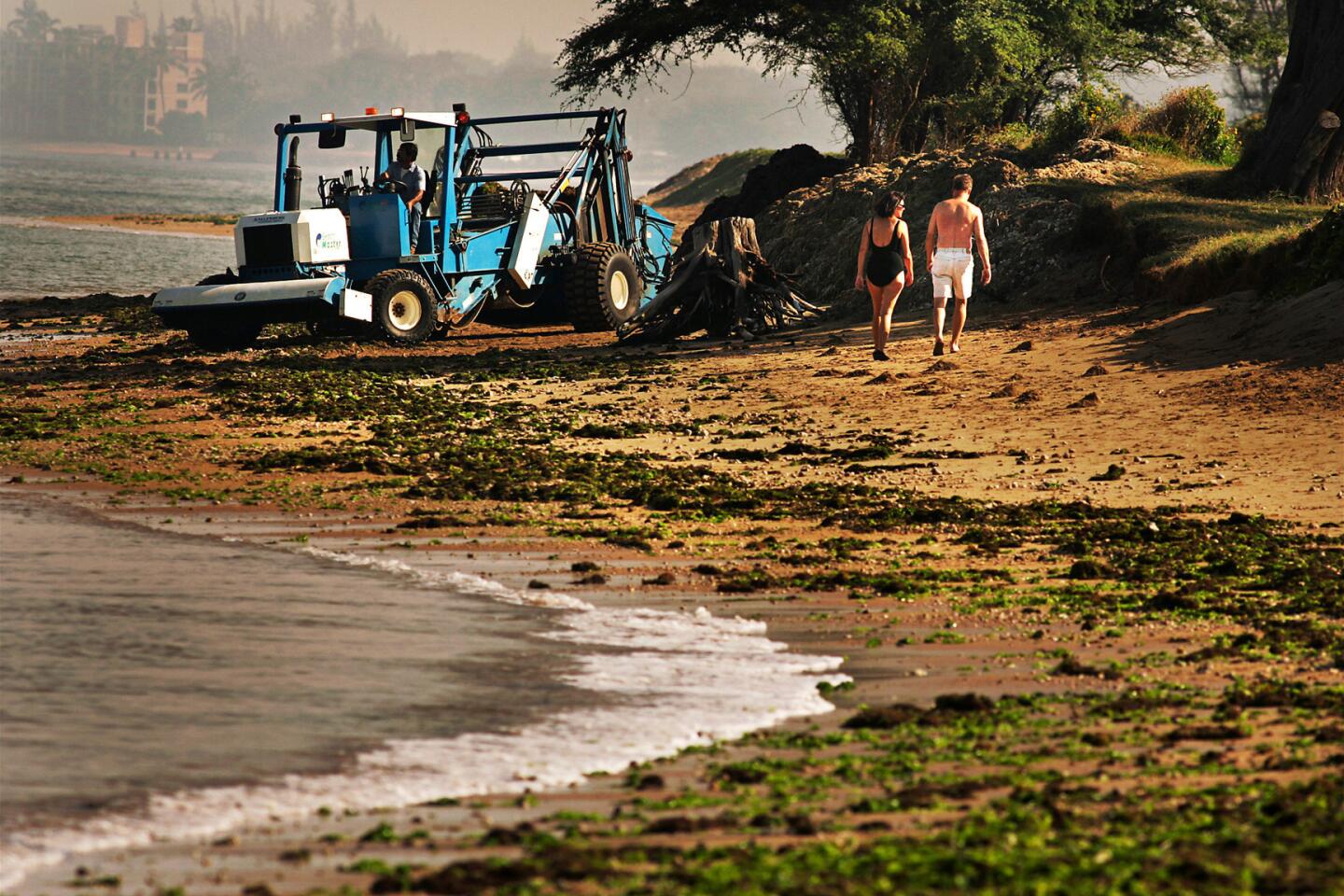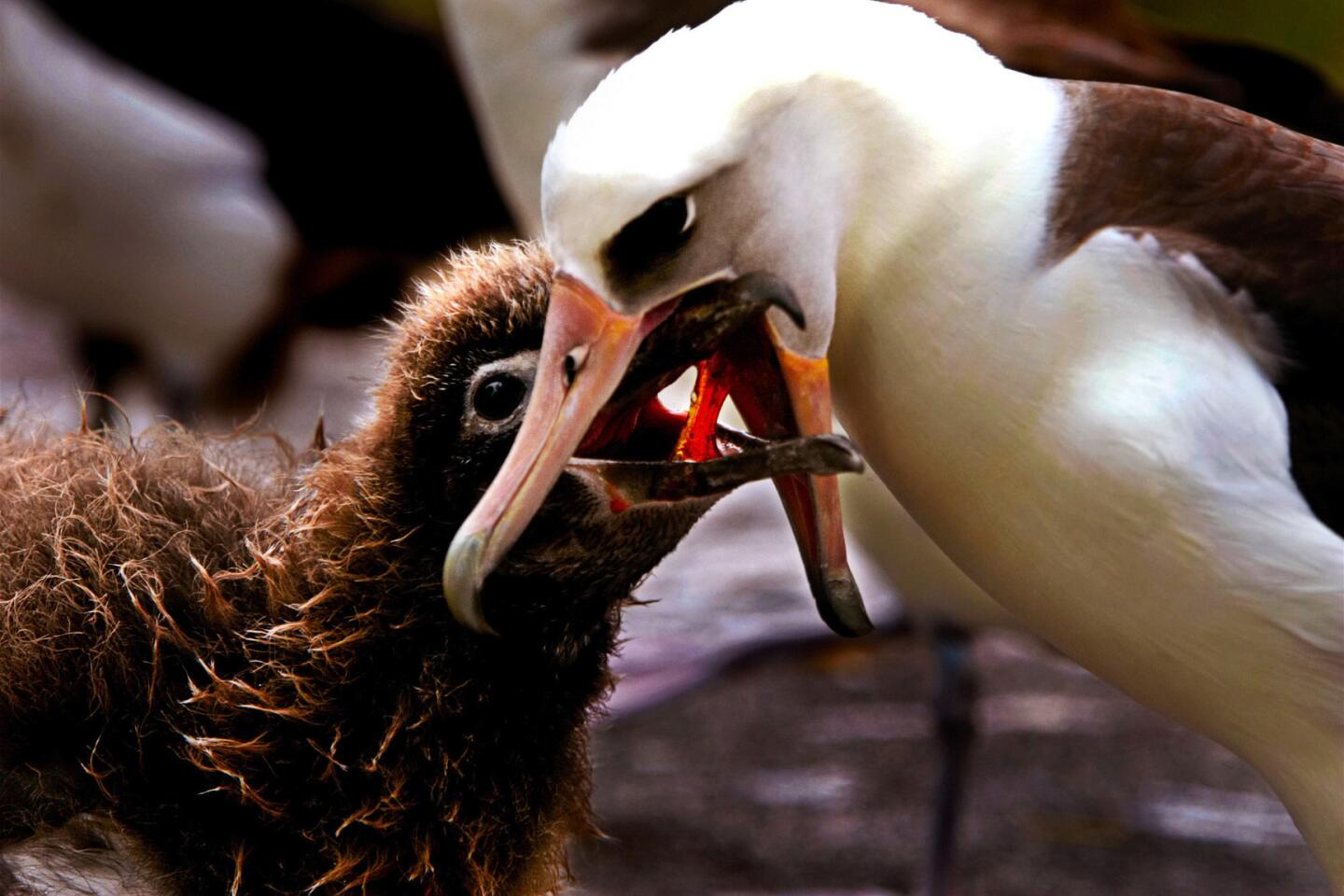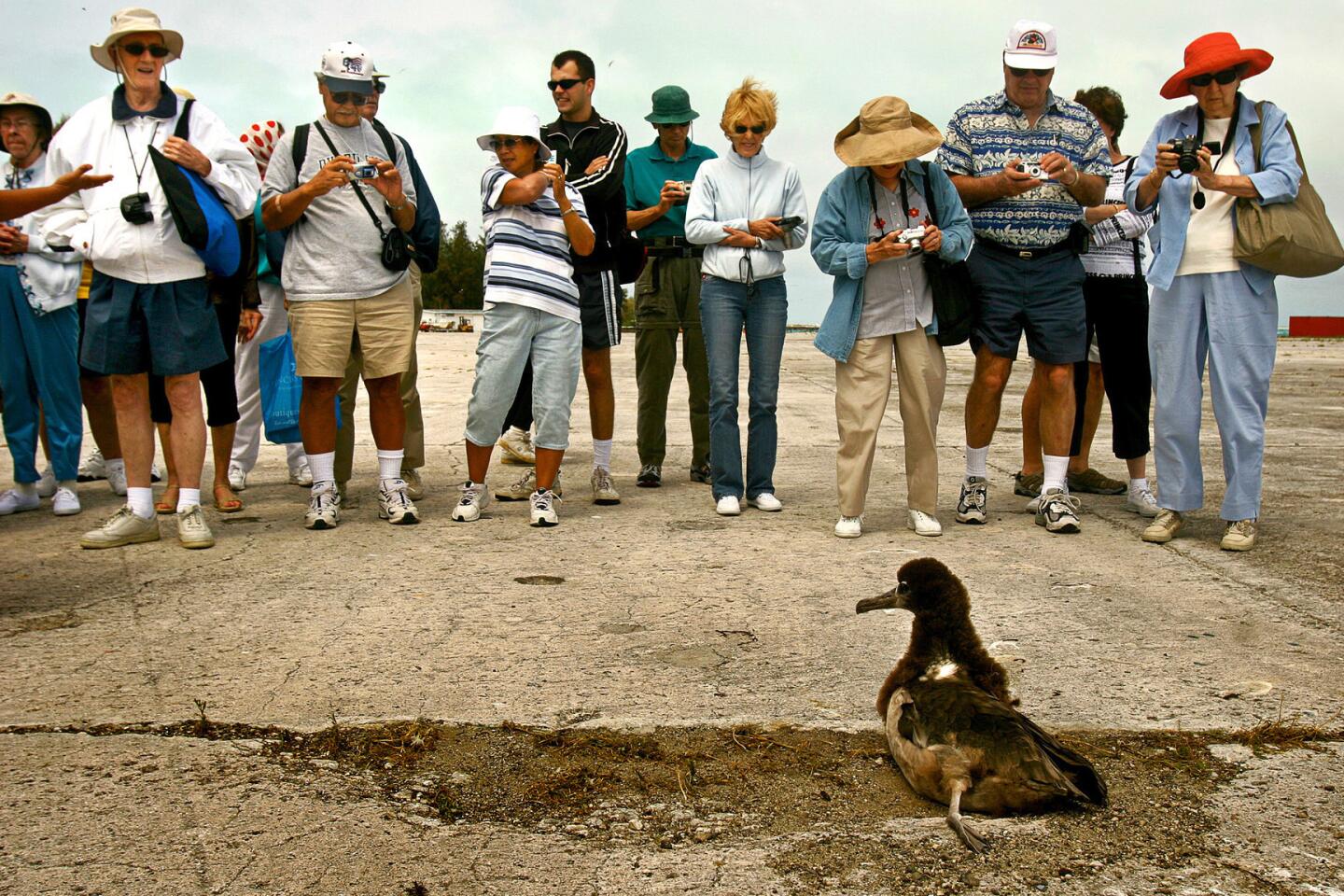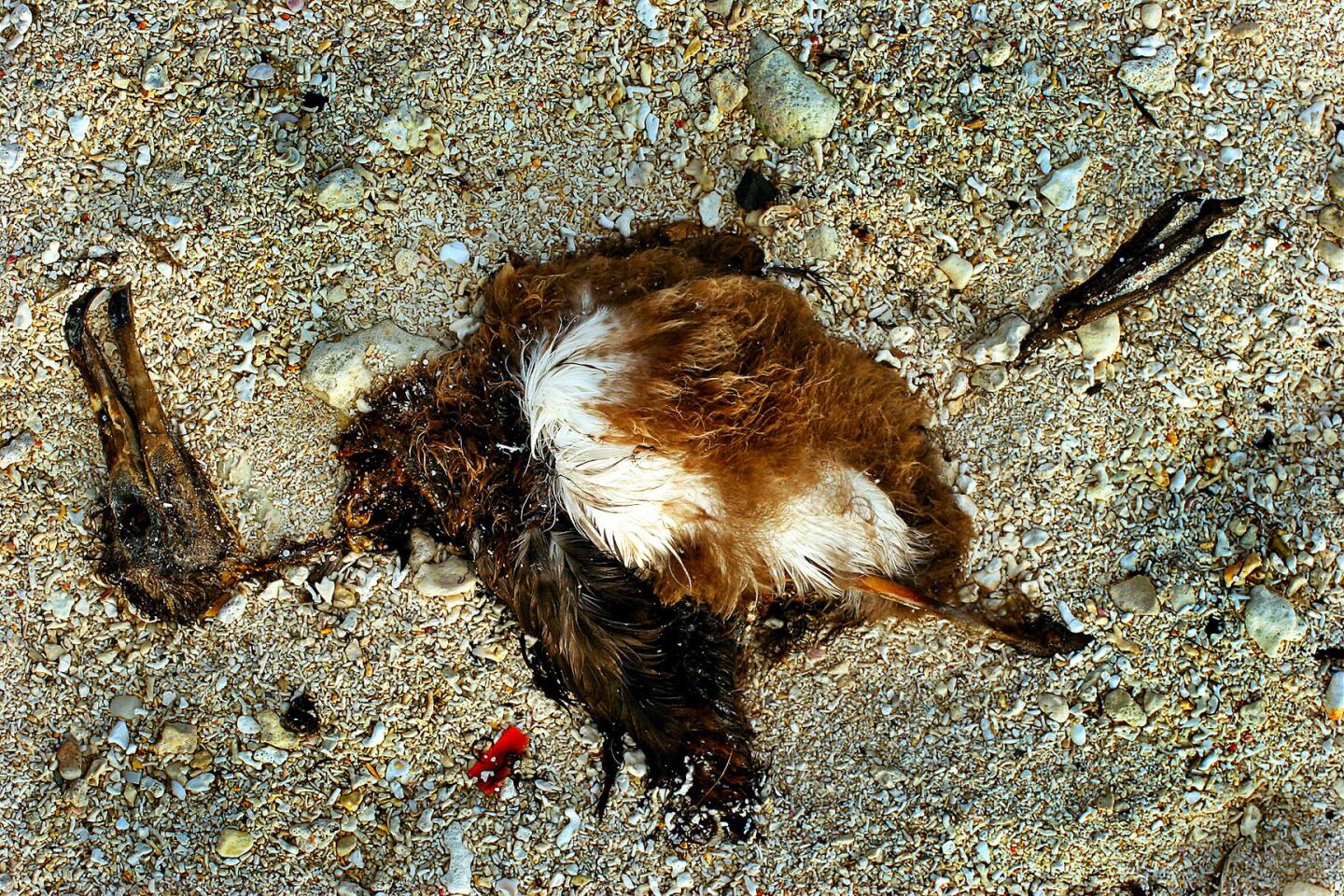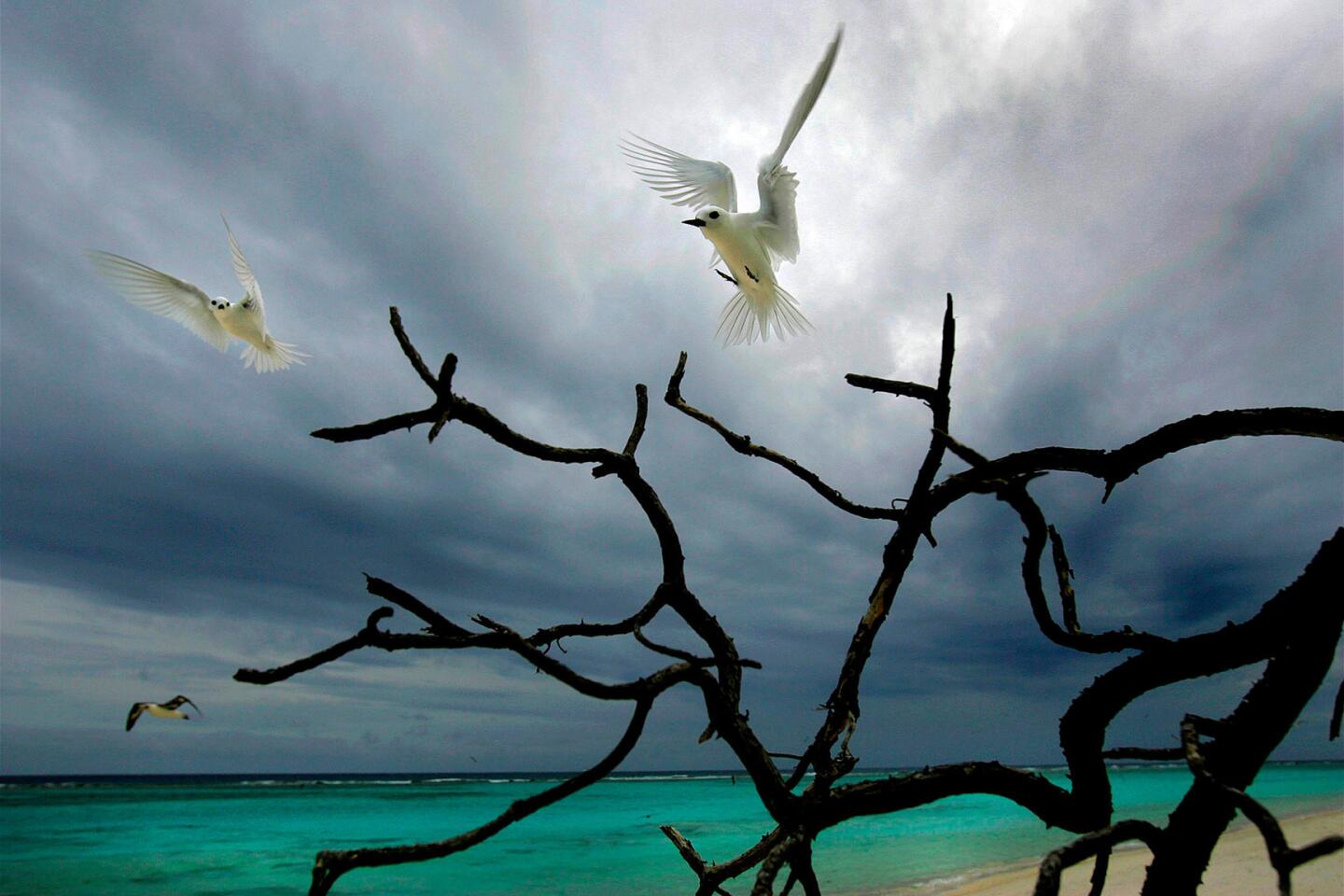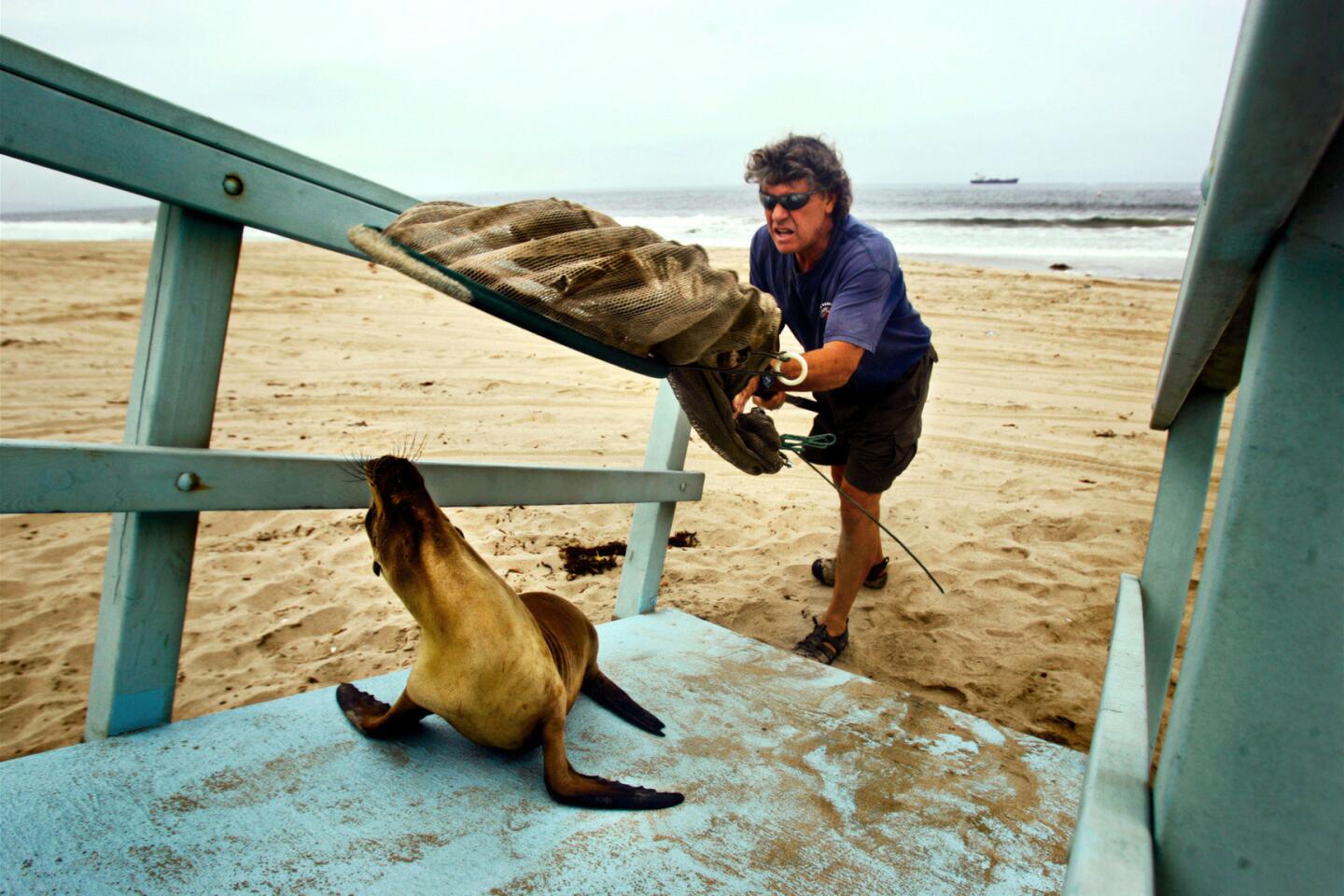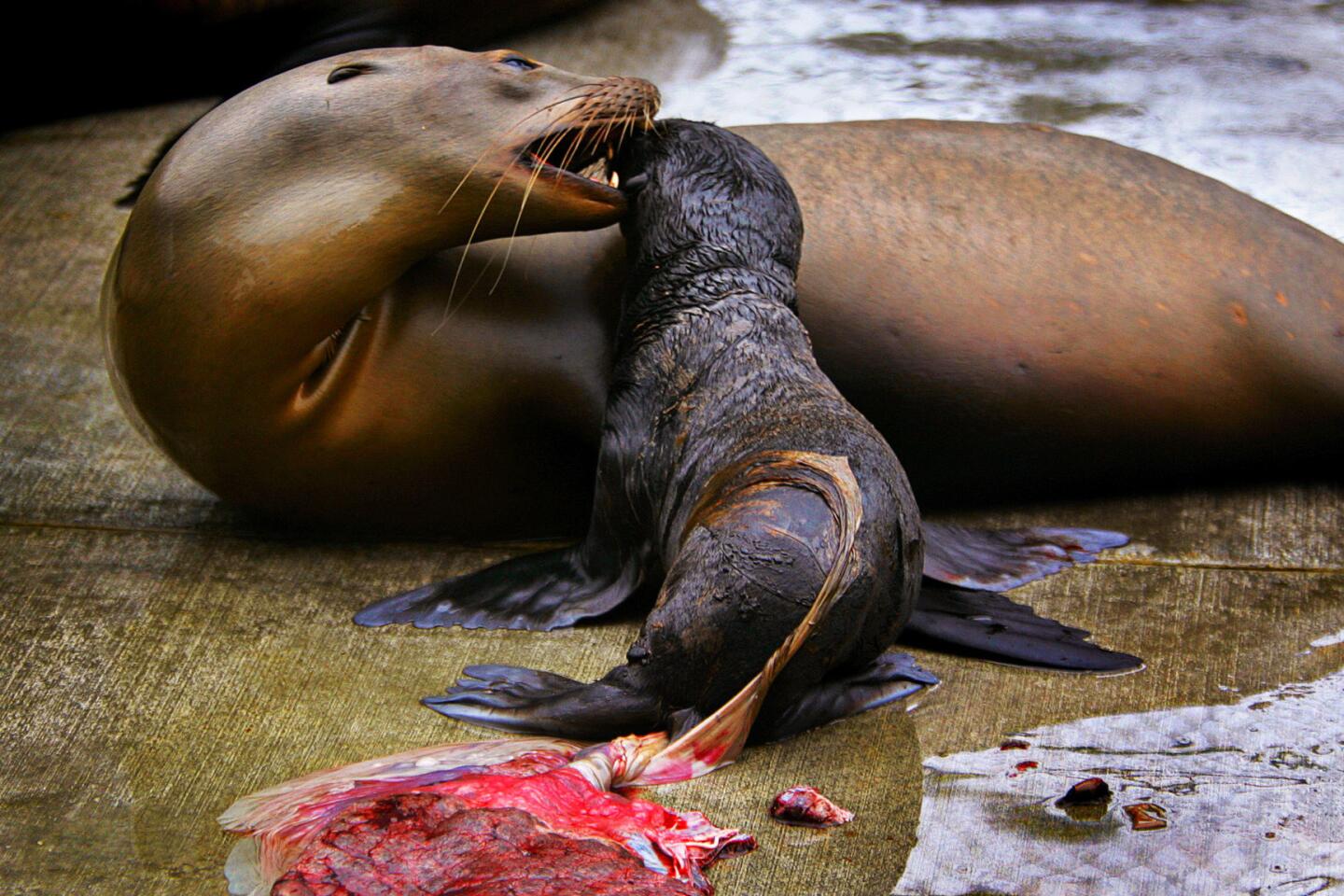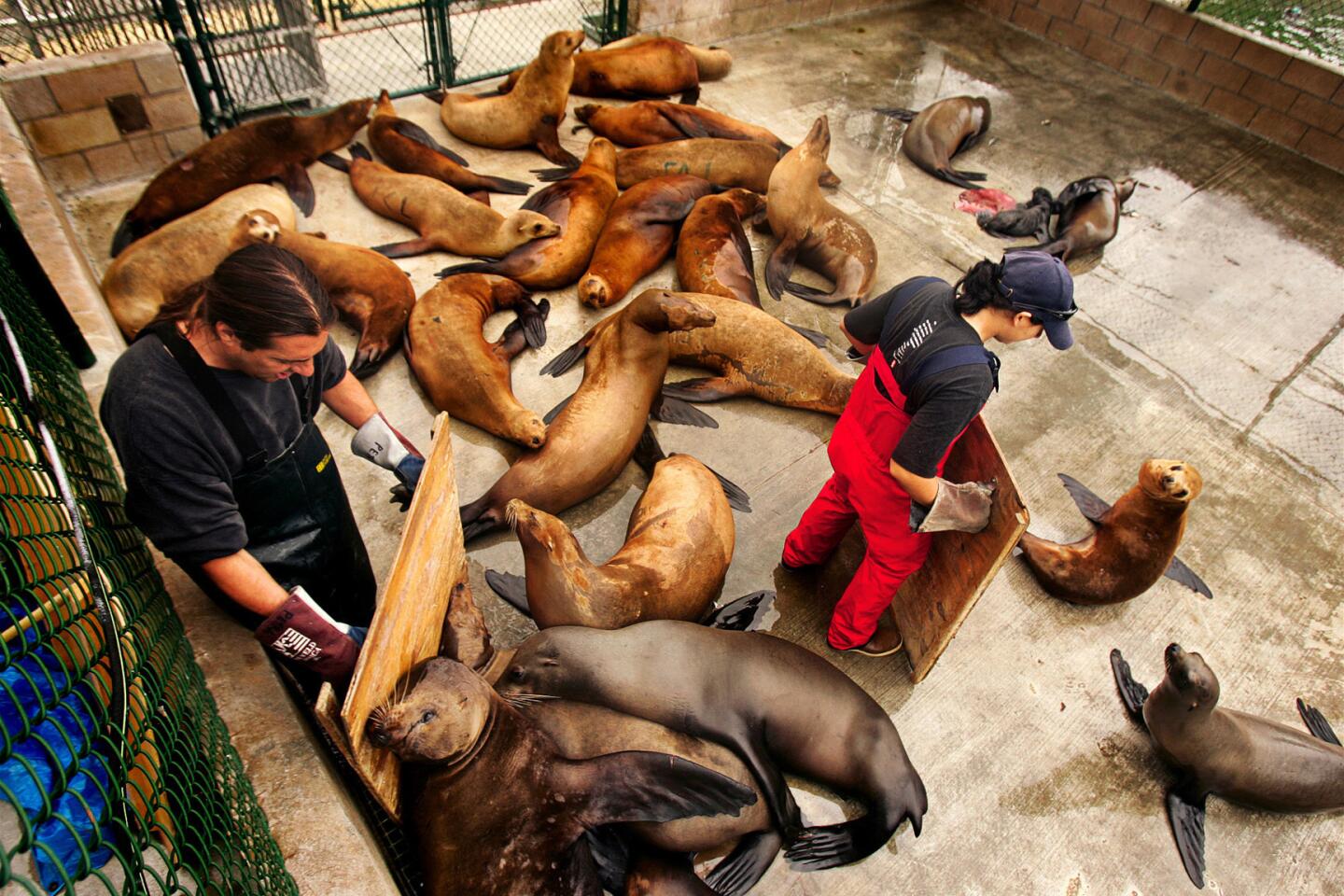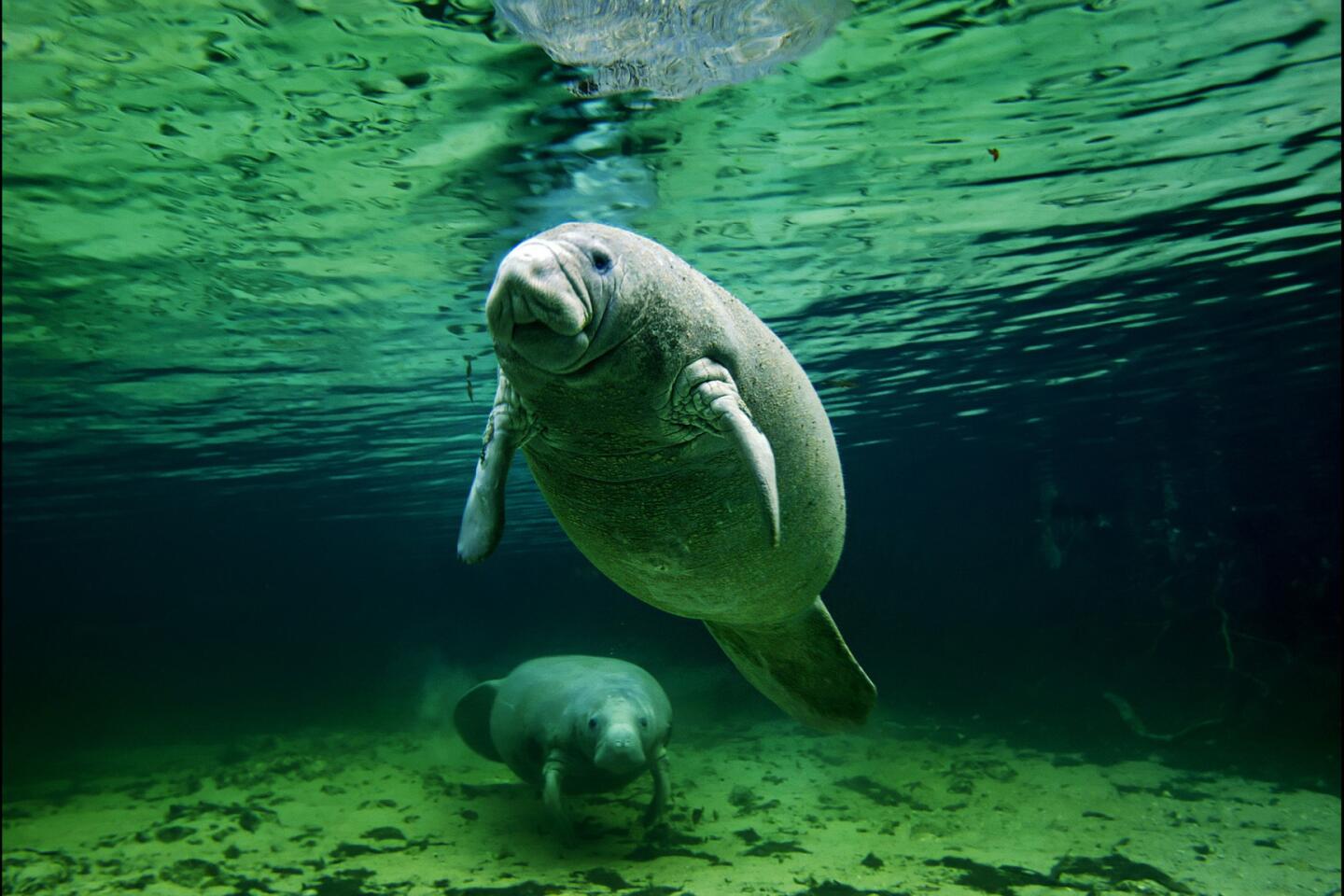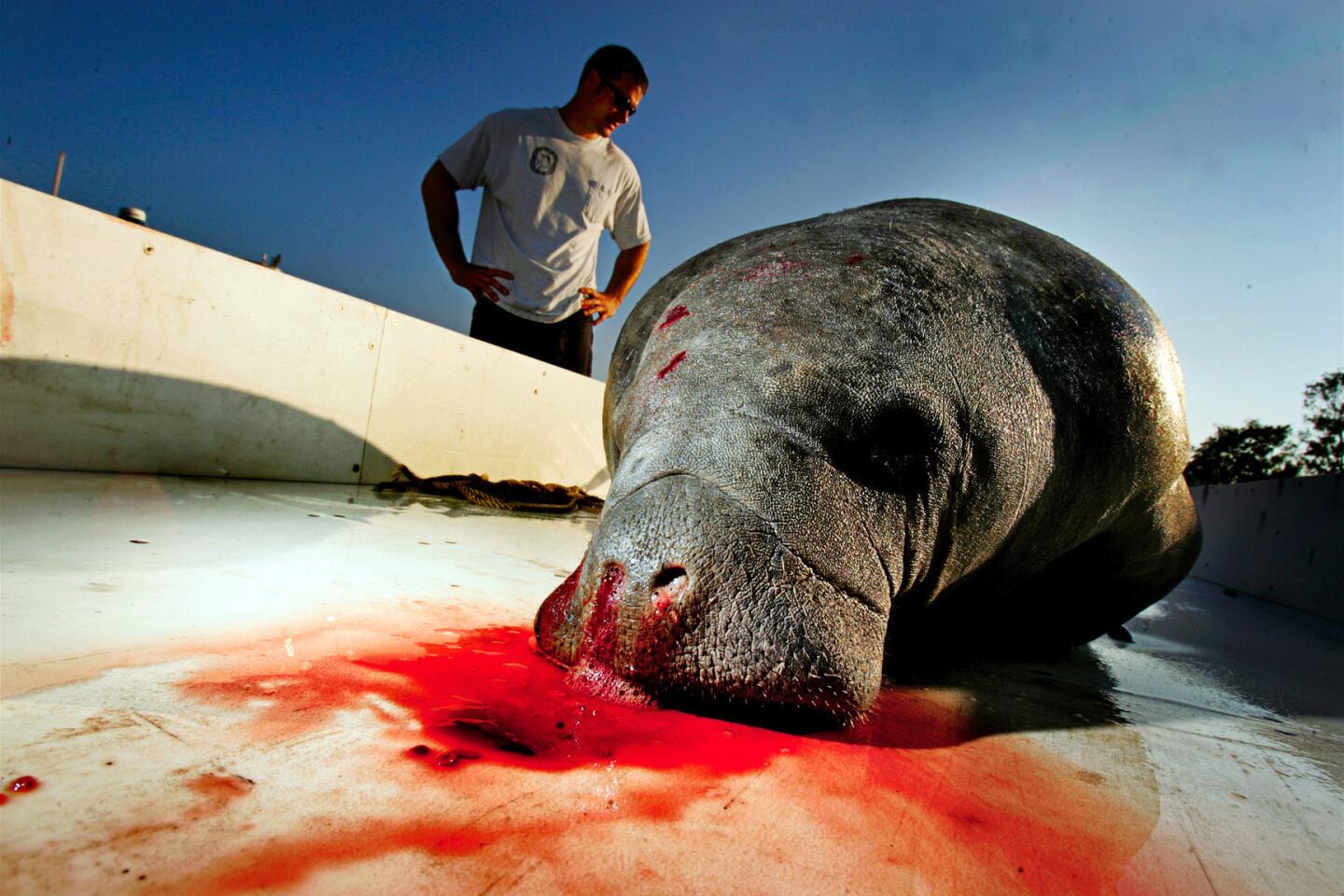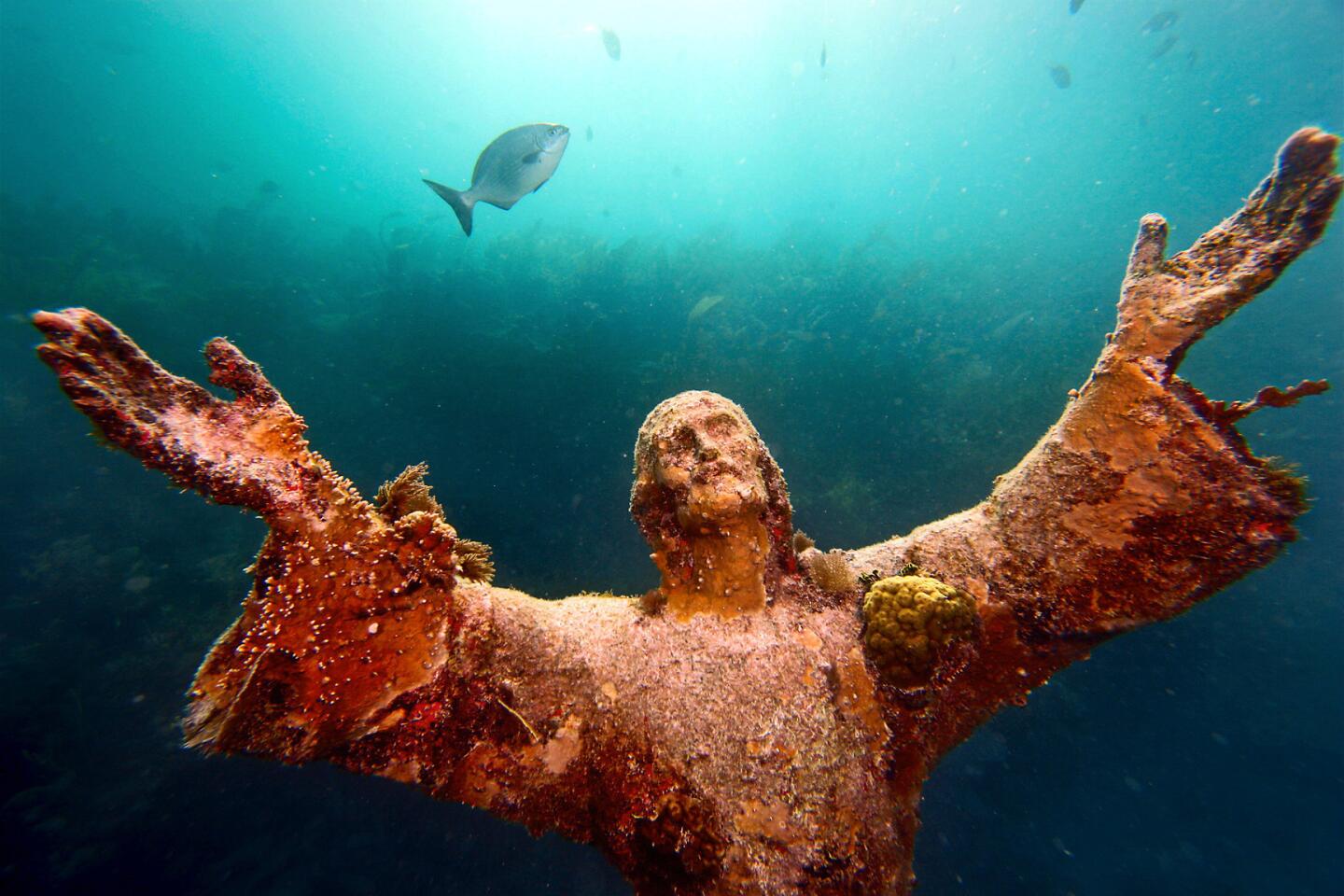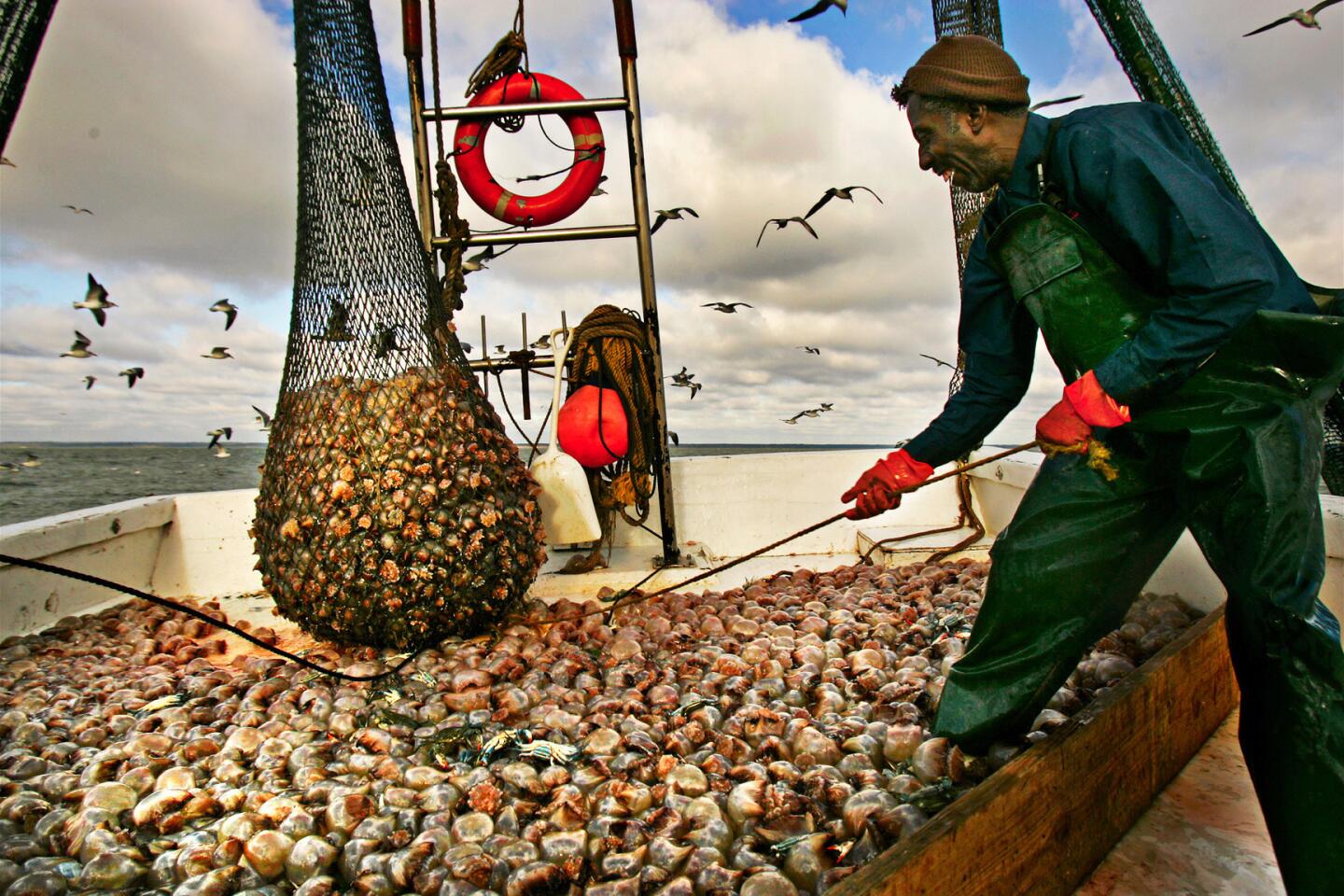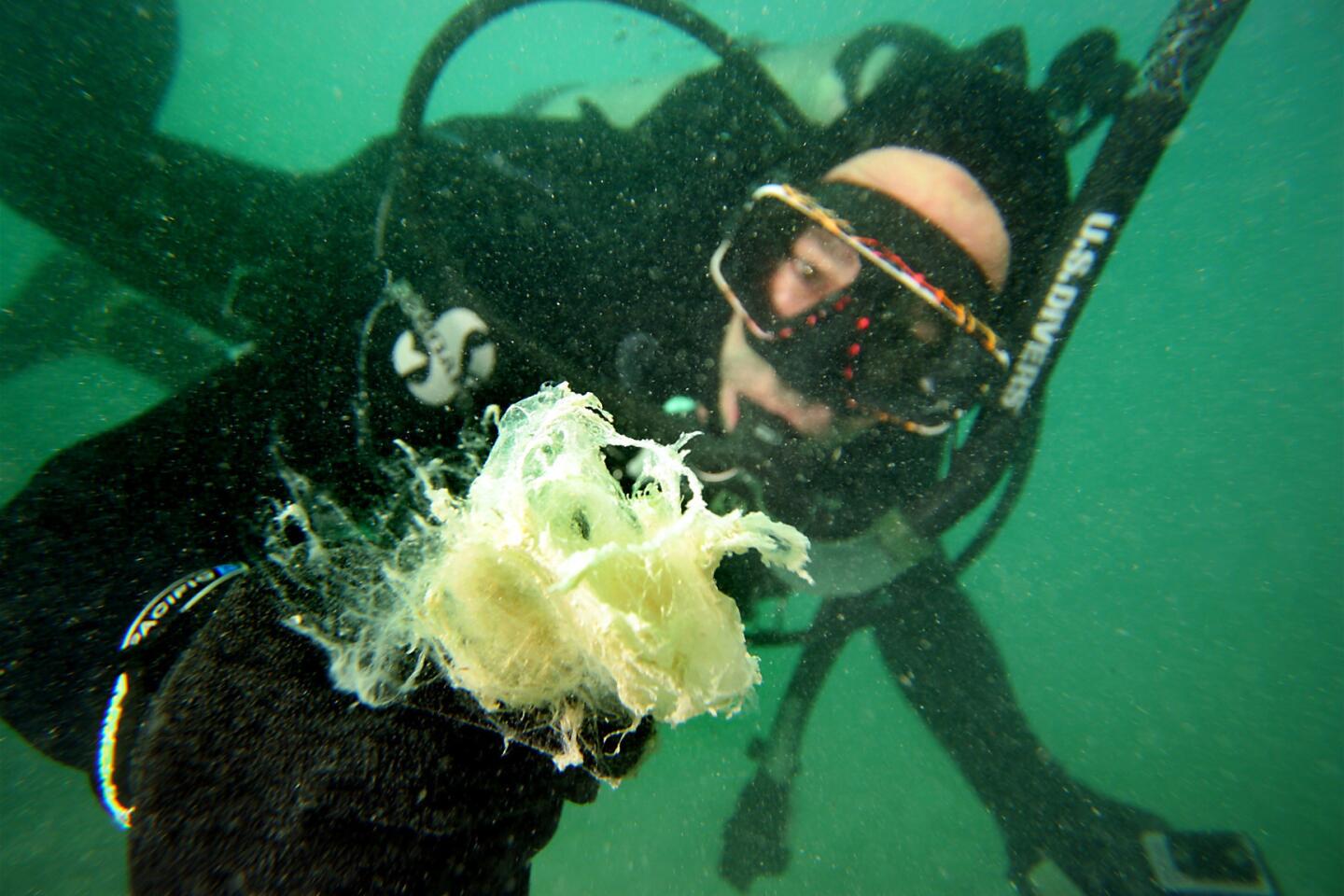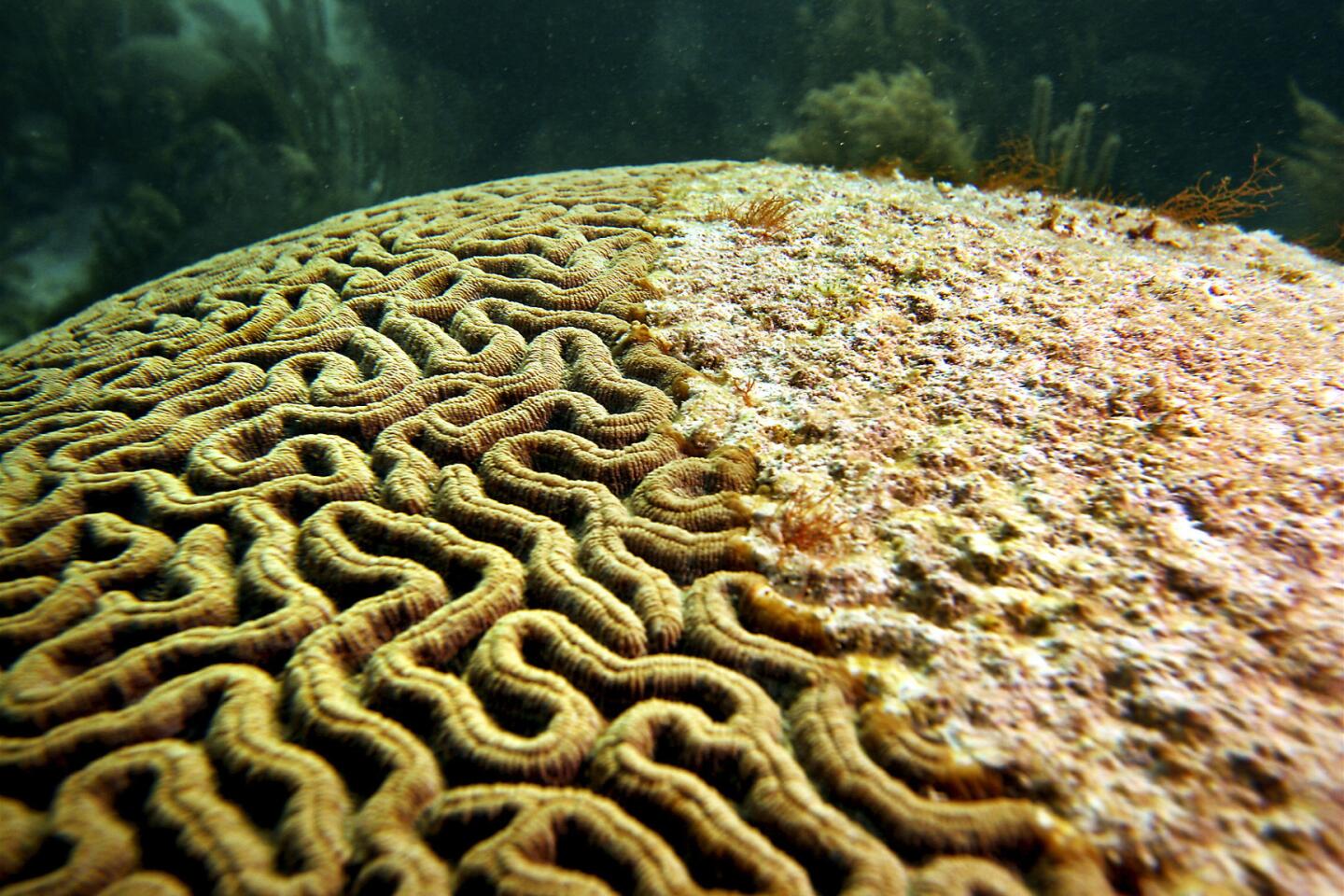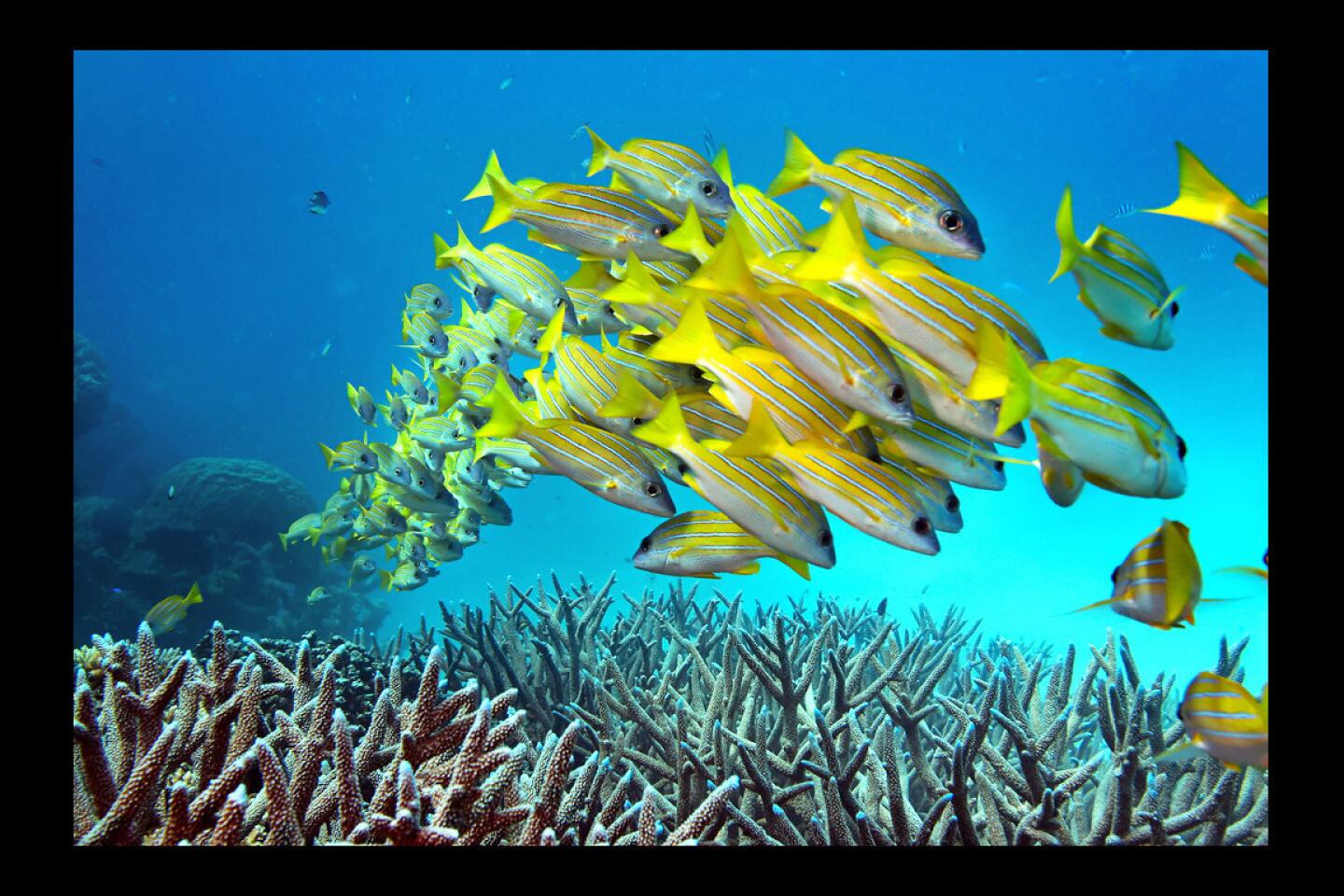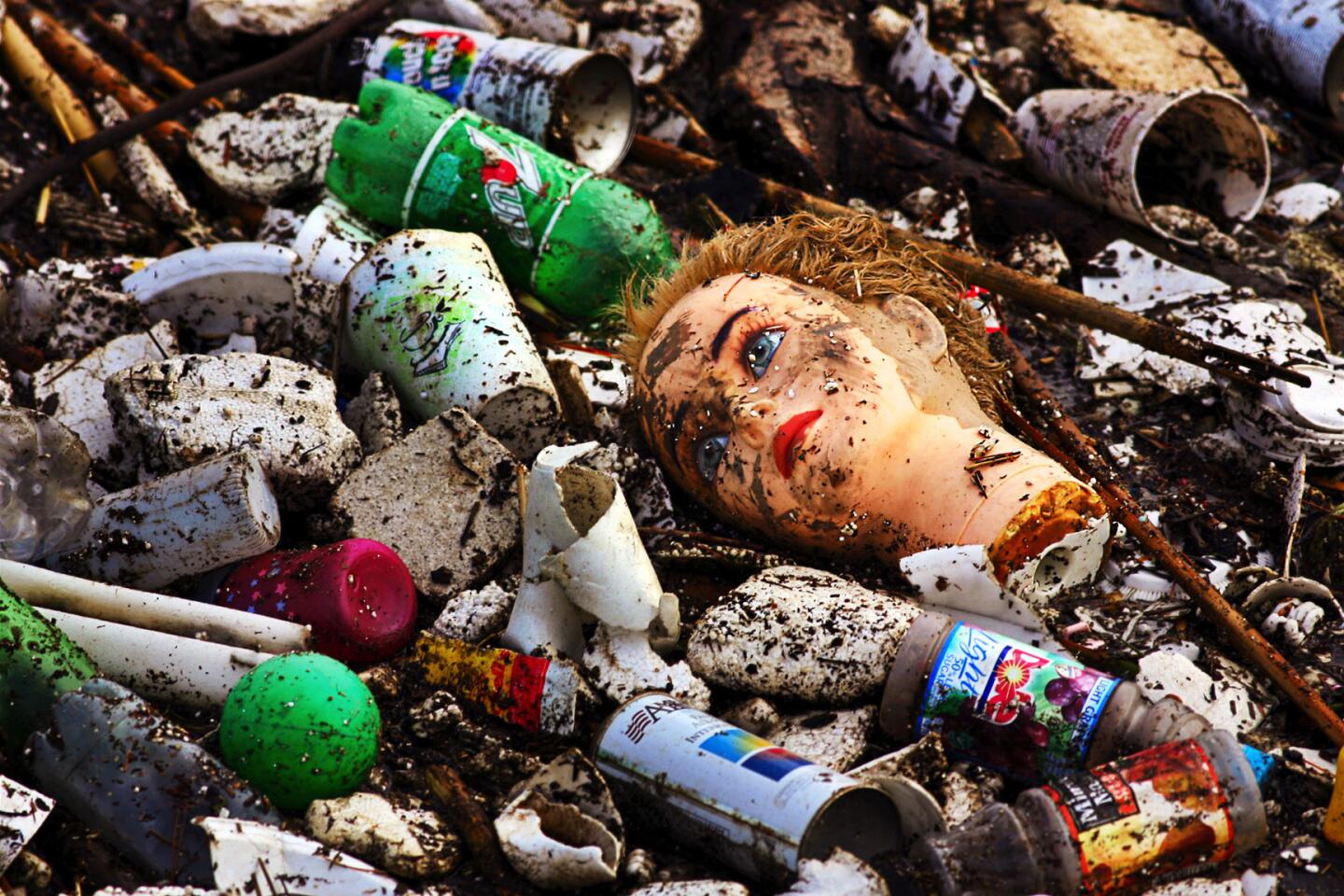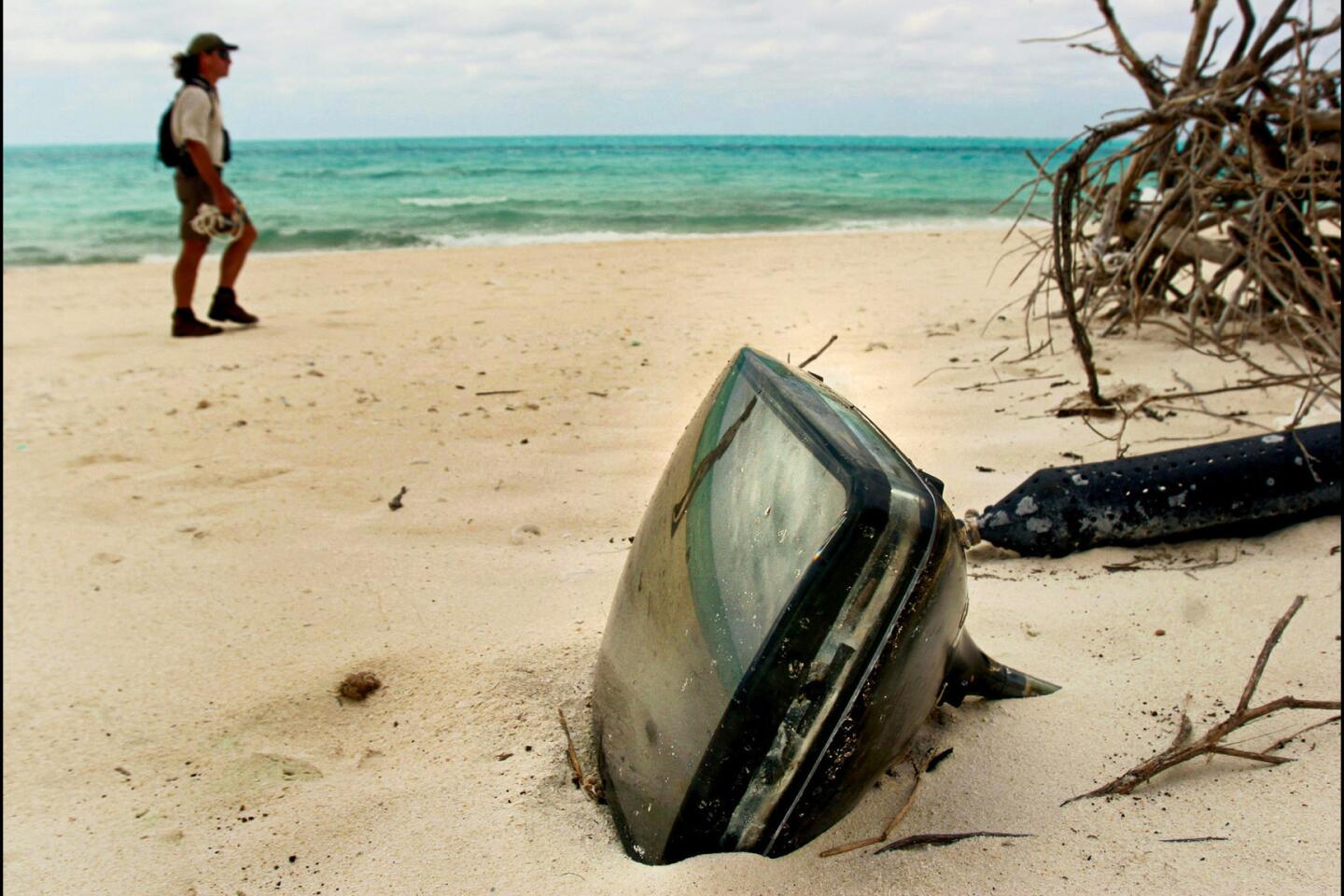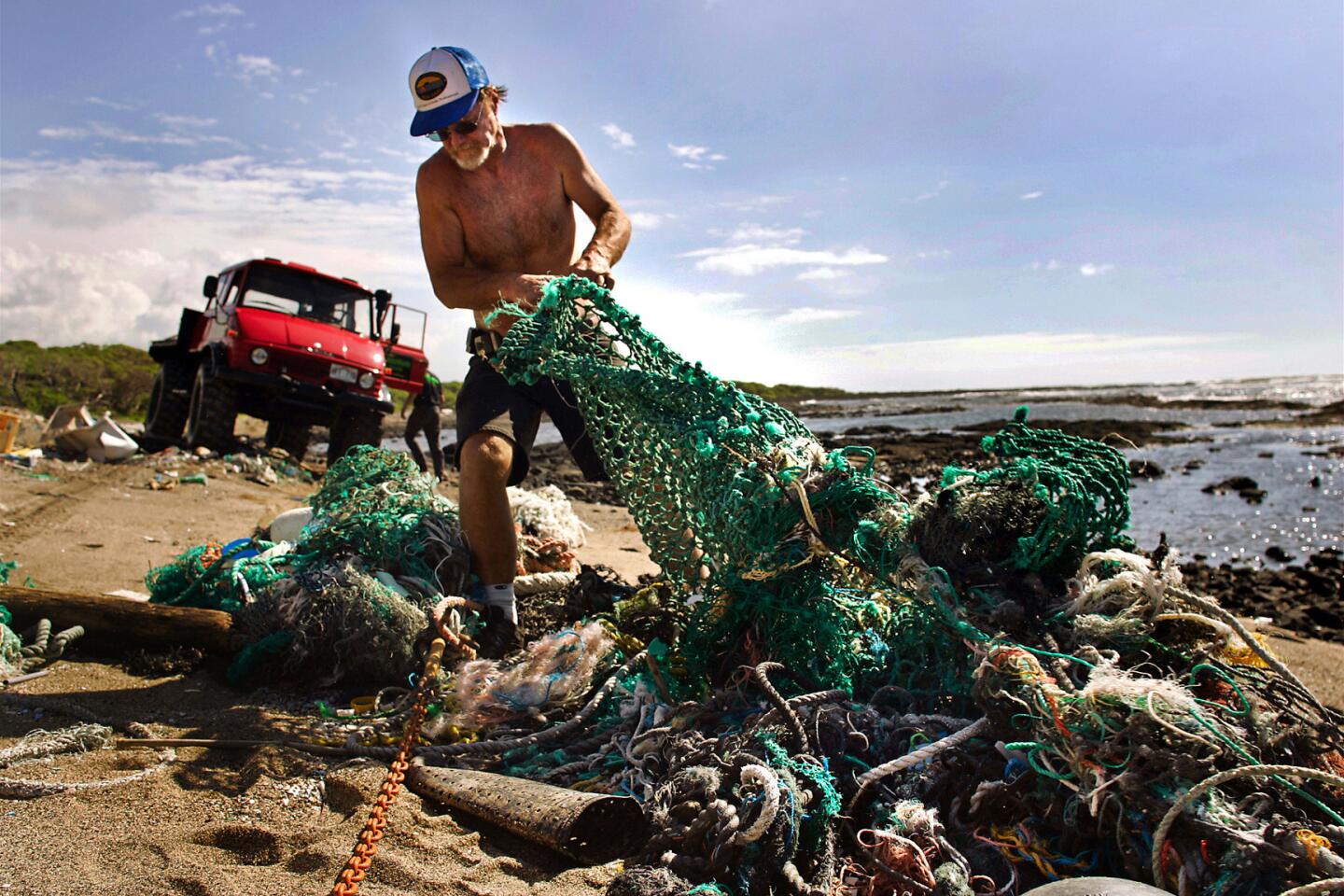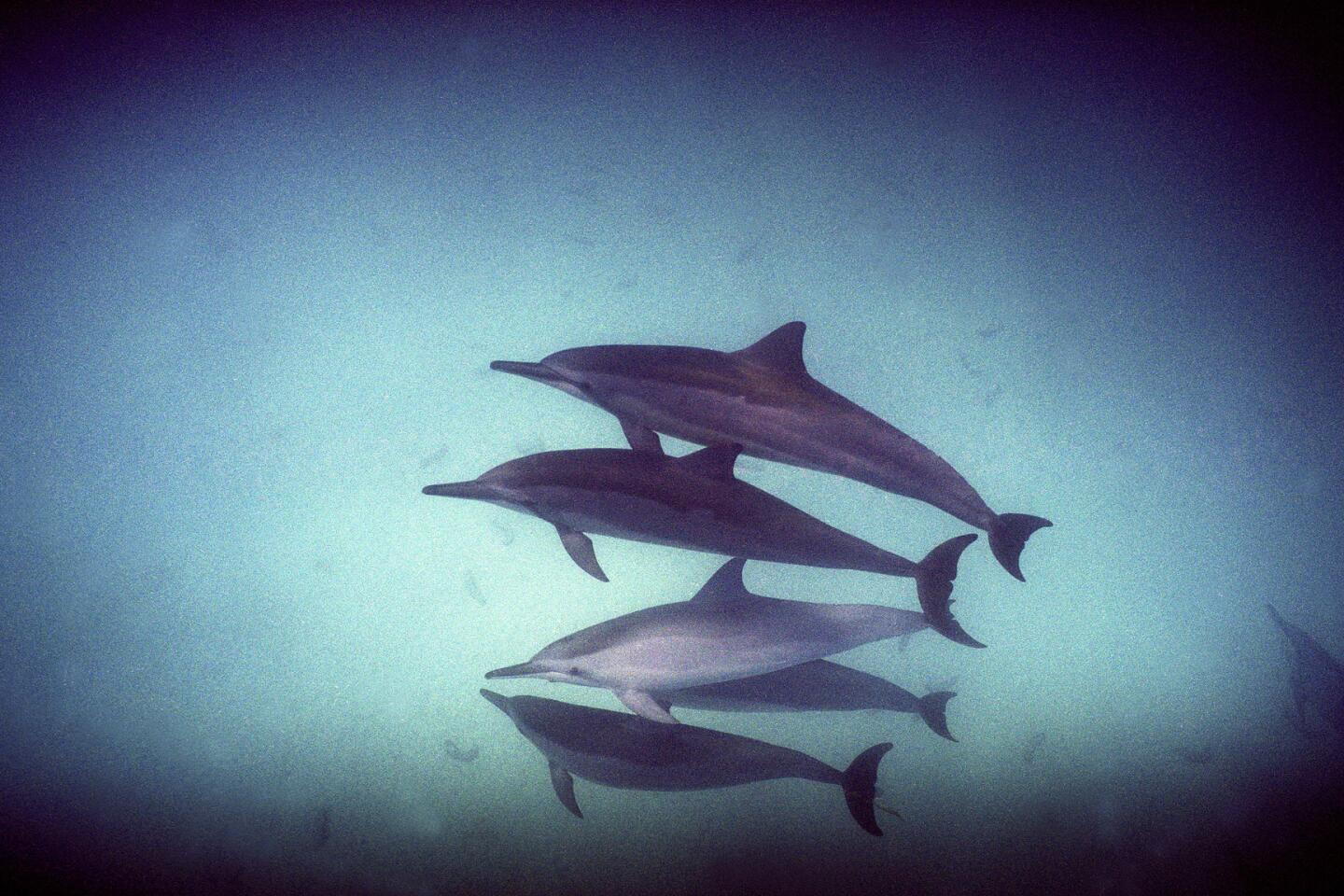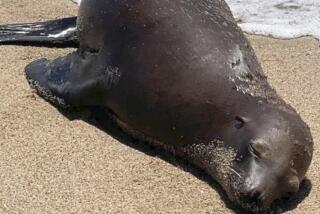Altered Oceans: Part Two: Sentinels Under Attack
Reporting From SAN FRANCISCO — After the last patient of the day walked out the front of Raytel Medical Imaging clinic, veterinarian Frances Gulland slipped an oversized animal crate through the back door.
Inside was a California sea lion. The animal was emaciated, disoriented and suffering from seizures.
A female with silky, caramel-colored fur, wide-set eyes and long whiskers, she was named Neuschwander, after the lifeguard who had found her six weeks earlier, comatose and trembling under a pier at Avila Beach near San Luis Obispo.
Taken to the Marine Mammal Center near Sausalito, Neuschwander showed signs of recovery at first. Her eyes began to clear and focus. She frolicked in the small pool in her chain-link enclosure and wolfed down mackerel at feedings. Then she relapsed.
She quit eating and lost 40 pounds. Her sunken eyes darted around, as if tracking a phantom just outside the cage. Her head bobbed and weaved in erratic figure eights.
Neuschwander was loaded into a crate at the nonprofit center, the world’s busiest hospital dedicated to the care of wild marine mammals, and trucked across the Golden Gate Bridge. Gulland, the center’s director of veterinary science, wanted to scan Neuschwander’s brain at the imaging clinic.
After sedating the sea lion, Gulland and four assistants lifted the animal onto a gurney. They inserted a breathing tube into her throat and rolled the gurney into the great thrumming MRI machine.
Gulland, an upbeat, 46-year-old native of Britain, took a last look at Neuschwander as the machine closed around her. She hoped the sea lion could be saved.
Neuschwander was exhibiting the classic symptoms of domoic acid poisoning, a condition that scrambles the brains of marine mammals and causes them to wash ashore in California as predictably as the spring tides.
They pick up the acid by eating anchovies and sardines that have fed on toxic algae. Although the algae have been around for eons, they have bloomed with extraordinary intensity along the Pacific coast for the last eight years.
The blooms are part of a worldwide pattern of oceanic changes that scientists attribute to warming waters, excessive fishing, and a torrent of nutrients unleashed by farming, deforestation and urban development.
The explosion of harmful algae has caused toxins to move through the food chain and concentrate in the dietary staples of marine mammals.
For the last 25 years, the federal government has tracked a steady upswing in beach strandings and mass die-offs of whales, dolphins and other ocean mammals on U.S. coasts.
More than 14,000 seals, sea lions and dolphins have landed sick or dead along the California shoreline in the last decade. So have more than 650 gray whales along the West Coast.
In Maine two years ago, 800 harbor seals, all adults with no obvious injuries, washed up dead, and in Florida the carcasses of hundreds of manatees have been found in mangrove forests and on beaches.
The surge in mortality has coincided with what Florida wildlife pathologist Greg Bossart calls a “pandemic” of algae and bacteria. Although some of the deaths defy easy explanation, telltale biotoxins have turned up in urine, blood, brains and other tissue.
Sometimes the toxins kill animals outright, such as the manatees found dead in Florida, blood streaming from their noses.
In other cases, they kill slowly by promoting tumor growth or compromising immune systems, leaving marine mammals vulnerable to parasites, viruses or bacteria. Scientists believe the episodic die-offs of bottlenose dolphins along the Atlantic and Gulf coasts that began in the late 1980s may stem from toxic algae that weaken the animals and enable a virus related to canine distemper to attack the lungs and brain.
Sea turtles in Hawaii have been found with fist-sized tumors growing out of their eyes and mouths and behind their flippers. Scientists say the growths are the result of a papilloma virus and an ancient microorganism called Lyngbya majuscula, which appears as a hairy weed that has been spreading in tropical and subtropical waters. The tumors doom the turtles by inhibiting their ability to see, eat or swim.
As they watch the oceans disgorge more dead and dying creatures, scientists have come to a disquieting realization: The proliferation of algae, bacteria and other microbes is making the oceans less hospitable to advanced forms of life — those animals most like humans.
“Marine mammals share our waters, eat some of the food we eat and get some of the same diseases we get,” said Paul Sandifer, chief scientist for the Oceans and Human Health Initiative of the National Oceanic and Atmospheric Administration.
“If environmental conditions are not good for these sentinels of the sea, you can believe it won’t be good for us either,” Sandifer said. “What we allow to flow into the sea will come back to bite us. You can bet on it.”
Marine algae, or phytoplankton, occur naturally and make up the first link in the oceanic food chain. A quart of seawater typically contains hundreds of thousands of phytoplankton and millions of bacteria, viruses and protozoans, all in concentrations that keep each other in check.
That equilibrium can be upset when certain types of algae overwhelm their competitors. The change is most pronounced in coastal waters, and scientists believe it is tied to nutrient pollution from a variety of human activities.
Toxic algae thrive on the same elements that turn lawns green and make crops grow — nitrogen, phosphorus and iron.
California, the nation’s most populous state with more than 36 million people, sends billions of gallons of partially treated human waste into the ocean every day. Sewage treatment cuts down on disease-causing bacteria but does little to remove nutrients.
Seasonal rains carry enormous loads of urban and agricultural runoff into the ocean, much of it down drainage canals and rivers from the dairies, orchards and farms that make California the nation’s largest agricultural producer.
The destruction of coastal wetlands, which filter nitrogen and other nutrients, also plays a role, as does over-harvesting of shellfish and sardines, menhaden and other algae-eating fish.
Climate change is another factor. Warmer seawater speeds up microbial growth and allows aggressive algae and bacteria to move into areas once too cold for them. Commercial ships can help the spread, transporting the algae in ballast water.
The type of algae that poisoned Neuschwander began blooming riotously in California waters in 1998.
It has the tongue-twisting name Pseudo-nitzschia (SUE-doh NICH-e-yah). A fraction of the thickness of a human hair, this javelin-shaped, single-cell organism slides through seawater on a coating of mucus and churns out domoic acid, a neurotoxin.
Pseudo-nitzschia blooms all along the West Coast, especially around bays and estuaries fed by major rivers. Unlike some other toxic blooms, which are often called red tides, these aren’t visible because their greenish-brown coloring blends into the seawater.
Researchers studying Pseudo-nitzschia off the mouth of the Mississippi River have unearthed evidence in the seafloor that agricultural runoff from the nation’s heartland triggers the outbreaks.
Scrutinizing core samples from five locations in the Gulf of Mexico, they found thick layers of microscopic silica shells of Pseudo-nitzschia that coincided with a deposit of nitrates and sediment that had flowed down the Mississippi.
The evidence is preserved in strata that resemble a layer cake. It shows that Pseudo-nitzschia didn’t proliferate until the 1950s, when grain farmers began widespread use of chemical fertilizers.
In contrast to the Mississippi Delta, such telltale clues cannot be seen in marine sediments off the Pacific coast because the seafloor is constantly being churned up.
As a result, West Coast scientists have been looking for chemical signatures that would directly link river discharges to the toxic blooms.
For the last three years, USC researchers David A. Caron and Astrid Schnetzer have focused on a “hot zone” of Pseudo-nitzschia spanning 155 square miles of coastal waters off the mouths of the Los Angeles and San Gabriel rivers.
The researchers are still looking for the link. But one thing is clear, said Caron, a biological oceanographer: “There is a big dose of nutrients.”
Knowing about the effects of domoic acid, scientists wonder whether algae blooms explain the freakish behavior of coastal wildlife observed periodically over the years.
Some speculate that Pseudo-nitzschia caused the onslaught of crazed seabirds near Capitola, Calif., in 1961 that inspired Alfred Hitchcock’s movie “The Birds.” Hitchcock, who was living in nearby Scotts Valley, read a newspaper story about sooty shearwaters “wailing and crying like babies,” crashing into streetlights and windows, nipping at people and vomiting up anchovies.
In 1998, sailors in Monterey Bay began bumping into dark objects in the water. They thought they were floating logs. They weren’t. They were the bodies of sea lions.
That year, more than 400 washed ashore, dead or dying, victims of neurotoxic poisoning.
California’s five marine mammal rehabilitation centers were overwhelmed. Every year since, they have been crowded with sea lions trembling with seizures.
This spring, the Marine Mammal Care Center at Ft. MacArthur in San Pedro was often as busy as an inner-city emergency room. Ailing sea lions were packed into chain-link cages. Rescue workers kept bringing in new patients in pickup trucks. The animals needed injections of anti-seizure medicine or had to be hooked up to saline drips to flush the neurotoxin from their systems.
On one typical day, listless sea lions were flopped on their sides, flippers tucked in, too exhausted to lift their heads. One was agitated, head weaving to and fro, grunting and snorting. Another chewed obsessively on a flipper.
All were females found comatose or acting strangely on the beach. Many were pregnant and had seizures just after giving birth.
“A California sea lion has as warm and strong of a maternal instinct with a newborn as you can see in any animal,” said Robert DeLong, a government ecologist who has studied sea lions in their Channel Islands rookeries for 35 years.
Domoic acid can destroy that maternal bond.
Sea lions suffering from neurotoxic poisoning usually show no interest in their young. Some that previously cared for their pups shun them after suffering seizures or even attack them when they try to suckle.
“I came in one day and pieces of the pup were everywhere,” said Jennifer Collins, a veterinarian who worked at the Marine Mammal Care Center in San Pedro. “We initially thought someone had broken in and macerated one of the animals. Then we pieced it together and realized that a mother had done it to her own pup.”
Scientists first became aware of domoic acid and its toxicity in 1987, when three people died and at least 100 others were sickened after eating contaminated mussels from Prince Edward Island in Canada. Nineteen people were hospitalized with seizures, comas and unstable blood pressure.
Many of the patients never recovered gaps in their memory, lending this malady a new name: amnesic shellfish poisoning. An examination of brain tissue from the three people who died showed severe loss of nerve cells, mostly in the hippocampus, a part of the temporal lobe that resembles a seahorse and plays a key role in memory and navigation.
Reported cases of the illness are rare in North America because health authorities closely monitor shellfish for toxins and because such seafood makes up a tiny fraction of most people’s diets. But for animals that consume little else, domoic acid is a recurring danger.
The acid mimics a neurotransmitter, overstimulating neurons that retain memory. The acid prompts nerve cells to fire continuously until they swell and die.
During spring and summer, when Pseudo-nitzschia blooms off the California coast, male sea lions don’t eat. They are too busy guarding their breeding territory on the Channel Islands, where females mate soon after delivering pups.
The females, in contrast, are ravenous feeders while pregnant and while nursing. They gorge on anchovies and sardines that have fed on toxic algae. Domoic acid doesn’t appear to affect the fish, but sea lions eat anchovies in such quantities that they accumulate a toxic load.
Frances Gulland and other researchers have been collecting miscarried sea lion fetuses and stillborn pups on San Miguel Island. To their surprise, domoic acid has turned up in the urine of these pups.
The neurotoxin is typically flushed from an animal in about four hours. But Gulland found that domoic acid can penetrate the placenta, bathing a developing fetus in the neurotoxin for days.
California sea lions have a keen sense of direction. Although their habitat ranges from British Columbia to Baja California, they return to the same breeding beaches on the same islands year after year.
But after attaching satellite transmitters to the animals, Gulland and other researchers found that many victims of domoic acid poisoning — even those that appeared fully recovered — lost their way.
Some swam hundreds of miles out to sea and were never seen again, bizarre behavior for creatures that spend their lives in coastal waters.
Others washed up again on beaches, too addled to make it on their own. One swam in tight circles up the Salinas River.
Neuschwander was one of those who could not find their bearings.
After spending a month at the Marine Mammal Center near Sausalito last summer, the sea lion was eating voraciously and seemed so vigorous that Gulland thought she was ready to fend for herself again. She was released back into the ocean in San Mateo County.
A week later, Neuschwander was found stranded again. This time, she was more than 100 miles inland from her natural home along the coast. She had traveled up rivers and drainage canals and ended up on a hillside near Sacramento International Airport.
She had an enormous gash running from her chest to her back, possibly from a run-in with a barbed-wire fence. She snapped at anyone who came close.
Back at the Marine Mammal Center, Neuschwander wouldn’t eat and began weaving her head again in endless figure eights.
Gulland and her staff shaved a wide band of fur off the sea lion’s head, attached a dozen electrodes and hooked them to an electroencephalogram to measure brain activity. The needle jumped up and down, a sign that Neuschwander was continuing to have seizures, though there were no visible tremors.
“The damage to the hippocampuses will help trigger seizures, and further seizures will cause further cell damage,” Gulland said. “You get into this whole vicious cycle.”
So Neuschwander was driven across San Francisco Bay and put into the MRI machine at Raytel Medical Imaging, a clinic near UC San Francisco Medical Center. After the magnets whirled, a computer screen displayed cross-section images of her brain.
Dr. Jerome A. Barakos, a clinical professor and director of neuro-imaging at the clinic, appeared in his white coat. He was there to interpret the 250 images that spooled out of the machine.
“The anatomy of a sea lion is not too dissimilar to the human anatomy,” Barakos said. He confirmed Gulland’s fear. On the right side of Neuschwander’s brain, the hippocampus was severely atrophied. It looked less like a seahorse than like a withered tail.
Gulland paced around the lab, then pulled aside one of her assistants, Michelle Caudle.
“So do we euthanize her? Do we take her home and see how she does?” Gulland asked.
The two women shifted uncomfortably, arms folded across their chests. They talked about how the animal was losing weight and drifting in and out of delirium.
At 140 pounds, Neuschwander was 60 to 80 pounds lighter than a healthy adult female.
Caudle recalled how she wouldn’t eat the “happy fish,” laced with sedatives, that sea lions normally gulp down. Neuschwander shredded it, then spat it out.
“She looks terrible,” Gulland said. “I didn’t realize how thin she was. I mean, how much do we make her go through?”
Gulland got a faraway look in her eyes. Her face drooped.
“I’m OK with it,” Caudle said.
“I am too. That’s why we do it, right?”
To end the suffering.
Gulland blinked back tears. She took a deep breath and rejoined the group to announce the decision.
The team took five vials of blood for future studies. Then Gulland filled an enormous syringe with clear pink liquid, pressed the plunger and shot 15 ccs of sodium pentobarbitone, an overdose of the anesthetic, into a neck vein.
Neuschwander let out one last, rasping breath.
Gulland laid her hands on the sea lion’s body. The heart fluttered for a long two minutes.
Then it stopped.
Times staff writer Usha Lee McFarling contributed to this report.
Next: Altered Oceans, Part Three: Dark Tides, Ill Winds
Full coverage: Altered Oceans
More to Read
Sign up for Essential California
The most important California stories and recommendations in your inbox every morning.
You may occasionally receive promotional content from the Los Angeles Times.
